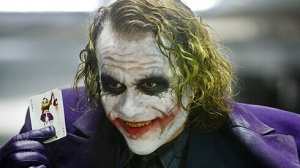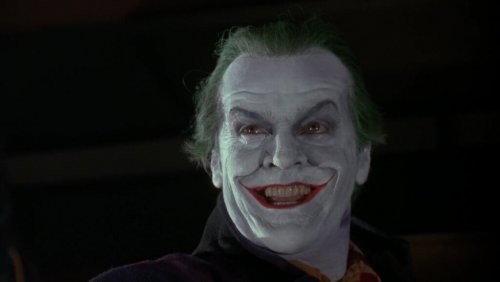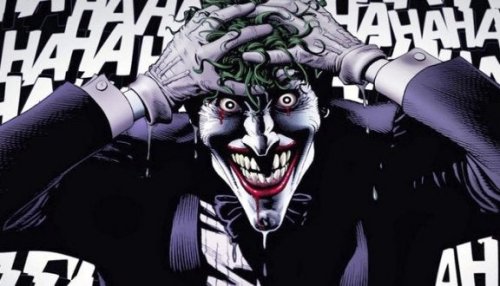The Joker, the Perfect Villain

The Joker is one of the public’s favorite villains. His popularity is so great that he doesn’t even need Batman for people to recognize him. A new movie is currently in theaters that revolves around his character. Joaquin Phoenix plays the title role.
Many actors have brought this particular villain to life. Heath Ledger’s Joker is perhaps one of the most outstanding personifications of the character. His work in this role got him a posthumous Oscar and made both the character and the actor into cinema icons. That’s not to say that any of the other actors who played the role, such as Jack Nicholson, weren’t great. These films have contributed greatly to the Joker’s mythos. They’re responsible for him being considered the archetypical villain.
“You see, in their last moments, people show you who they really are.”
-The Joker-
The evolution of The Joker
Until the 1940s, Batman was part of the Detective Comics series. At some point, Batman started to become more independent, eventually becoming the hero of a comic with his own name on the title. Just like all good superheroes, he needed a rival. That’s when the creators started to put the Joker together. The claims to who created this character are highly disputed. The first Joker looked similar to the card with the same name in poker. His schemes were less elaborate than the new joker and one of his main characteristics was how fashionable he was.

As time went on, this character became more popular. Eventually, he became an essential figure in the Batman comics. It’s as if the two characters were two sides of the same coin: one good, one evil. It seemed that Batman and his rival were completely inseparable.
This is the idea that acclaimed British Screenwriter Alan Moore tried to convey in Batman: The Killing Joke. He wanted people to see that hero and villain aren’t so different. Batman’s justice isn’t so pure as people might think. Nor is the Joker so purely evil. Batman: The Killing Joke came out at a time of crisis for the old order. The old publishing rules were no longer valid and the old ways were starting to lose their charm for people. Even the Joker’s jokes weren’t as funny as they used to be.
Moore managed to turn in a radical direction. He gave the Joker a new personality – one that was no longer shallow and one-dimensional. All the while, he never changed the Joker’s essence as a villain. Thanks to Moore, the Joker stopped being a secondary character. Before, even when the character was involved in interesting story arcs, he had been relegated to a place of secondary importance. He was nothing but a villainous foil for Batman.

After Alan Moore transformed him, public interest for this villain increased. People wanted to discover the truth about his dark and confusing past of which no one knows anything for certain. You’re curious to know whether he had an evil nature from birth or if, on the contrary, it was just a matter of a single “bad day”. Moore managed to put the pieces of the puzzle together and drew out the main characteristics of the Joker’s true personality and the motives for his madness.
Who’s the Joker?
His physical appearance is basically the opposite of that of Batman. The hero of the series is serious, dark, and comes with a tragic past. That contrasts sharply with the Joker’s eccentric and colorful appearance, reminiscent of a circus performer. His physical appearance, explained by the comic’s writers in many ways throughout his appearances, is due to the fact that he fell in a chemical tank. This disfigured his face and changed his skin tone. Some authors add makeup to this. Others say that the color of his lips is a result of contact with residues.
- In Batman: The Killing Joke, the Joker recalls his past in many ways. Some of them are flashbacks, but we don’t know whether any of these are true or not.
- In Mad Love, the Joker describes a sad past to Harley Quinn in which he had problems with his father. Nevertheless, we discover that he’d told Batman a similar version with some important variations.
- In Tim Burton’s Batman (1989), which had Jack Nicholson playing the role of the Joker, they even give him a name. They call him Jack Napier. You also become a witness to his transformation into the Joker through the chemical tank.
- Heath Ledger’s Joker took on a more realistic tone. It was closer to that of a criminal, a serial killer who always leaves his personal mark by the victim. He follows the original character from the early comics.
Thus, we don’t have a clear picture of the Joker’s past. However, different versions present different possibilities. In almost all the character’s incarnations, his past is blurry. The Joker tends to reinvent his own story and manipulate it with the goal of reaching an objective, such as what happens in Mad Love. You don’t know what’s real and what’s a lie, but you can imagine there’s a dark past there. It’s a past that perhaps isn’t so different from Batman’s. And perhaps that, along with a natural sadism, has created the character you have come to know.
Sadistic, extremely intelligent, always ready to mock, crazy, and manipulative. All of these words describe the Joker. His crazy behavior appears to be closely linked to the character and he manages to spread it to everyone around him. That’s exactly what happens to Harley Quinn. Even though she’s a psychiatrist, she falls in love with him and his madness. And the truth is that the Joker does have quite a bit of charm. He’s narcissistic, egocentric, and cruel, but he still mesmerizes you.
The Joker has a love for jokes and for laughing at things no one else would find funny. He mocks life and death, and his plans are twisted but intelligent. All of that makes him the perfect villain. He’s the absolute villain, as perfect as his archetype. And that has managed to attract many fans.
The villain
You don’t know anything for certain about the Joker’s past and Moore tried to blur the line between good and evil with the character. Nevertheless, the truth of the matter is that the Joker is the perfect psychopath. And he’s one of those literary villains who are psychopathic just because – you don’t know of any external cause that led him down that path. There are many versions of the character and they all propose different possibilities on the subject. Yet all of them are the same in one regard. They all flesh out a Joker who’s a sociopath without morals and whose only objective is to sow chaos.

People usually try to see the villain as everything the protagonist isn’t or can’t be. If Batman is order, for example, the Joker is chaos. If Batman is good, the Joker is evil. Even so, the figure of the villain is much more complex. People have been studying this topic from many different points of view. There are many types of villains and it isn’t easy to classify them.
You can find the archetype of the villain in a broad range of artistic works. Villains aren’t always characters. They could be institutions or groups, among other things. You tend to link them to stories and traditions. In these types of tales, the archetypes are very clear and the characters configure themselves correspondingly.
Vladimir Propp conducted a deep study on the morphology of the story. In it, he thought up a series of 31 common or recurrent points in all fairy tales. Of course, he also considered the role of the villain and their relationship to the hero in these stories. These functions have served for the construction of stories. They’ve also allowed for people to study storytelling. Furthermore, you don’t just see them in fairy tales. You can find them in longer works, comics, and films.
The figure of the hero seems to be essential for Propp’s morphology of the story. In the same way, all heroes need a villain. That is, a character who tries to sabotage the hero’s progress, hurts their family, destroys their plans, or contributes to the hero’s development and mythification.
“All it takes is one bad day to reduce the sanest man alive to lunacy. That’s how far the world is from where I am. Just one bad day.”
-The Joker-
The Joker is one of the public’s favorite villains. His popularity is so great that he doesn’t even need Batman for people to recognize him. A new movie is currently in theaters that revolves around his character. Joaquin Phoenix plays the title role.
Many actors have brought this particular villain to life. Heath Ledger’s Joker is perhaps one of the most outstanding personifications of the character. His work in this role got him a posthumous Oscar and made both the character and the actor into cinema icons. That’s not to say that any of the other actors who played the role, such as Jack Nicholson, weren’t great. These films have contributed greatly to the Joker’s mythos. They’re responsible for him being considered the archetypical villain.
“You see, in their last moments, people show you who they really are.”
-The Joker-
The evolution of The Joker
Until the 1940s, Batman was part of the Detective Comics series. At some point, Batman started to become more independent, eventually becoming the hero of a comic with his own name on the title. Just like all good superheroes, he needed a rival. That’s when the creators started to put the Joker together. The claims to who created this character are highly disputed. The first Joker looked similar to the card with the same name in poker. His schemes were less elaborate than the new joker and one of his main characteristics was how fashionable he was.

As time went on, this character became more popular. Eventually, he became an essential figure in the Batman comics. It’s as if the two characters were two sides of the same coin: one good, one evil. It seemed that Batman and his rival were completely inseparable.
This is the idea that acclaimed British Screenwriter Alan Moore tried to convey in Batman: The Killing Joke. He wanted people to see that hero and villain aren’t so different. Batman’s justice isn’t so pure as people might think. Nor is the Joker so purely evil. Batman: The Killing Joke came out at a time of crisis for the old order. The old publishing rules were no longer valid and the old ways were starting to lose their charm for people. Even the Joker’s jokes weren’t as funny as they used to be.
Moore managed to turn in a radical direction. He gave the Joker a new personality – one that was no longer shallow and one-dimensional. All the while, he never changed the Joker’s essence as a villain. Thanks to Moore, the Joker stopped being a secondary character. Before, even when the character was involved in interesting story arcs, he had been relegated to a place of secondary importance. He was nothing but a villainous foil for Batman.

After Alan Moore transformed him, public interest for this villain increased. People wanted to discover the truth about his dark and confusing past of which no one knows anything for certain. You’re curious to know whether he had an evil nature from birth or if, on the contrary, it was just a matter of a single “bad day”. Moore managed to put the pieces of the puzzle together and drew out the main characteristics of the Joker’s true personality and the motives for his madness.
Who’s the Joker?
His physical appearance is basically the opposite of that of Batman. The hero of the series is serious, dark, and comes with a tragic past. That contrasts sharply with the Joker’s eccentric and colorful appearance, reminiscent of a circus performer. His physical appearance, explained by the comic’s writers in many ways throughout his appearances, is due to the fact that he fell in a chemical tank. This disfigured his face and changed his skin tone. Some authors add makeup to this. Others say that the color of his lips is a result of contact with residues.
- In Batman: The Killing Joke, the Joker recalls his past in many ways. Some of them are flashbacks, but we don’t know whether any of these are true or not.
- In Mad Love, the Joker describes a sad past to Harley Quinn in which he had problems with his father. Nevertheless, we discover that he’d told Batman a similar version with some important variations.
- In Tim Burton’s Batman (1989), which had Jack Nicholson playing the role of the Joker, they even give him a name. They call him Jack Napier. You also become a witness to his transformation into the Joker through the chemical tank.
- Heath Ledger’s Joker took on a more realistic tone. It was closer to that of a criminal, a serial killer who always leaves his personal mark by the victim. He follows the original character from the early comics.
Thus, we don’t have a clear picture of the Joker’s past. However, different versions present different possibilities. In almost all the character’s incarnations, his past is blurry. The Joker tends to reinvent his own story and manipulate it with the goal of reaching an objective, such as what happens in Mad Love. You don’t know what’s real and what’s a lie, but you can imagine there’s a dark past there. It’s a past that perhaps isn’t so different from Batman’s. And perhaps that, along with a natural sadism, has created the character you have come to know.
Sadistic, extremely intelligent, always ready to mock, crazy, and manipulative. All of these words describe the Joker. His crazy behavior appears to be closely linked to the character and he manages to spread it to everyone around him. That’s exactly what happens to Harley Quinn. Even though she’s a psychiatrist, she falls in love with him and his madness. And the truth is that the Joker does have quite a bit of charm. He’s narcissistic, egocentric, and cruel, but he still mesmerizes you.
The Joker has a love for jokes and for laughing at things no one else would find funny. He mocks life and death, and his plans are twisted but intelligent. All of that makes him the perfect villain. He’s the absolute villain, as perfect as his archetype. And that has managed to attract many fans.
The villain
You don’t know anything for certain about the Joker’s past and Moore tried to blur the line between good and evil with the character. Nevertheless, the truth of the matter is that the Joker is the perfect psychopath. And he’s one of those literary villains who are psychopathic just because – you don’t know of any external cause that led him down that path. There are many versions of the character and they all propose different possibilities on the subject. Yet all of them are the same in one regard. They all flesh out a Joker who’s a sociopath without morals and whose only objective is to sow chaos.

People usually try to see the villain as everything the protagonist isn’t or can’t be. If Batman is order, for example, the Joker is chaos. If Batman is good, the Joker is evil. Even so, the figure of the villain is much more complex. People have been studying this topic from many different points of view. There are many types of villains and it isn’t easy to classify them.
You can find the archetype of the villain in a broad range of artistic works. Villains aren’t always characters. They could be institutions or groups, among other things. You tend to link them to stories and traditions. In these types of tales, the archetypes are very clear and the characters configure themselves correspondingly.
Vladimir Propp conducted a deep study on the morphology of the story. In it, he thought up a series of 31 common or recurrent points in all fairy tales. Of course, he also considered the role of the villain and their relationship to the hero in these stories. These functions have served for the construction of stories. They’ve also allowed for people to study storytelling. Furthermore, you don’t just see them in fairy tales. You can find them in longer works, comics, and films.
The figure of the hero seems to be essential for Propp’s morphology of the story. In the same way, all heroes need a villain. That is, a character who tries to sabotage the hero’s progress, hurts their family, destroys their plans, or contributes to the hero’s development and mythification.
“All it takes is one bad day to reduce the sanest man alive to lunacy. That’s how far the world is from where I am. Just one bad day.”
-The Joker-
All cited sources were thoroughly reviewed by our team to ensure their quality, reliability, currency, and validity. The bibliography of this article was considered reliable and of academic or scientific accuracy.
Propp, V., (1985): Morfología del cuento. Madrid, Akal.
This text is provided for informational purposes only and does not replace consultation with a professional. If in doubt, consult your specialist.







